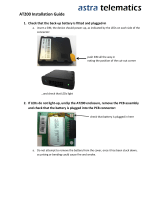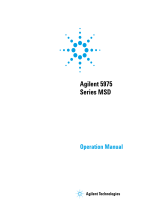Page is loading ...

Autotune
1 AUTOTUNE MODULE
1 INSTALLATION GUIDE
1 WIDEBAND O2 SENSOR AND
CABLE
1 CAN CABLE
1 WELD BOSS
2 DYNOJET DECALS
2 VELCRO STRIPS
1 ALCOHOL SWAB
3 ZIP TIES
2 POSI-TAPS
PARTS LIST
IAT-200.06
Wideband O2 Controller for Power Commander V
Single Channel Module Installation Guide
PLEASE READ ALL DIRECTIONS BEFORE STARTING INSTALLATION

2 AUTOTUNE SINGLE CHANNEL MODULE INSTALLATION GUIDE
The Autotune kit is a universal product that can be utilized on any model using the PCV and which has a 12v power
source. The system is not NOT intended to disable, eliminate, or replace stock OEM O2 sensors that may or may not
be present on the vehicle.
INSTALLATION
Installing the Weld Boss
Many stock and aftermarket exhausts come equipped with an O2 sensor. If your system uses a M18x1.5mm thread
then you can simply use this location for the Autotune sensor. If you have to drill a hole for a new bung (mild steel
bung included), we recommend doing so before the catalytic converter (if applicable). Positioning the weld bung in
a location where multiple cylinders collect is the preferred location. If your application has a “2-into-2” design, it’s
recommended to position the weld bung/sensor approximately 6-inches from the exhaust port on the respective
cylinder you wish to tune.
1 Install the Autotune module near the PCV.
2 Connect the Autotune module to the PCV using the
supplied CAN cable. It does not matter what port the
cable is connected to.
3 Connect the O2 sensor cable to the O2 sensor and
route the cable to the Autotune module ensuring the
cable will not get pinched or damaged by the exhaust.
The cable can be trimmed shorter if desired.
4 Connect the O2 sensor cable to the Autotune Module.
5 Connect the BLACK wire from the AT200 to a good
chassis ground using either one of the supplied
Posi-taps or ring lug. The negative side of the battery
is a good location.
6 Connect the RED wire of the AT200 to a switched
12v source using the supplied Posi-tap. The power
for the tail light is a good location. Most PCV install
guides will tell you the wire color for this location.
7 Block or disable the clean air injection system if
applicable (see tech tips).
Mount the weld boss in a manner that reduces the risk
of moisture contamination on the sensor. Condensation
can build up in the exhaust pipes and potentially
damage the sensor. Ideally, you should orient the
weld boss so the sensor is between the 9 o’clock and
3 o’clock position. A 10° inclination off the horizontal
plane should be considered a minimum.
Note: Verify you have adequate clearance for the sensor
and wiring harness. Make sure the O2 sensor harness
is as straight as possible. If you must secure the
harness to keep away from danger make sure you do
not squeeze the sheathing of the harness.
Installing the Autotune Module

AT-200
USING AUTOTUNE
The Autotune kit when used in conjunction with the PCV allows the bike to be automatically tuned to a target air/fuel
ratio. To use this feature you must fi rst enable Autotune in the PCV.
1 Click Power Commander Tools >Configure >Features
Enables and Input Selections or press CTRL+F.
2 Check the box next to Auto Tune to enable the
Autotune feature.
3 If you are using a switch to turn Autotune ON/OFF,
check the box next to Auto Tune Switch.
4 Click Configure to adjust the Autotune settings.
How much time after starting the engine the software waits
until it starts sampling.
The temperature the engine needs to reach before the software
starts sampling (optional wiring needed to function).
The maximum the software will trim per session.
Shows current table being altered Most maps from Dynojet will include a base Target AFR
table. These settings are intended to deliver optimal
performance while still maintaining decent fuel mileage
in the cruise area (for most models).
5 To alter the AFR target click on Target AFR in the tree
view.
6 Expand each cylinder and/or gear if necessary to
view the corresponding table. If necessary type in
different values in the cells. Multiple cells can be
highlighted by using click/drag with the mouse.

4 AUTOTUNE SINGLE CHANNEL MODULE INSTALLATION GUIDE
• If you should see abnormally high values in the trim tables then check the following:
• Intake leaks
• Exhaust leaks - check at all exhaust junctions
• Sensor condition - (see sensor test )
• Make sure the clean air system is blocked (if applicable). Also called the PAIR valve, the clean air system
draws fresh air out of the air box and dumps into the exhaust port to help ignite any unburnt fuel in the
exhaust. This extra air will skew the AFR readings of the Autotune module.
• Dynojet does not recommend inputting values in the 0% column of the Target AFR tables. If you should need to
tune the 0% column to combat popping on deceleration input values directly in the Fuel tables.
• If fuel mileage is a concern then you can alter the Target AFR values in the cruise range. Dynojet considers the
cruise range to be around 5-20% throttle. Dynojet does not recommend making the bike any leaner than 14.7 in the
Target AFR cells.
• Dynojet has found that for the best compromise of fuel mileage and throttle response to set the cruise range to
13.7-14.0.
• For all other ranges 12.8-13.4 seems to work best. For the best results it is recommended to bring the bike to an
Authorized Tuning Center to have them verify the AFR values.
• Make sure the sensor is not dropped or subjected to wet conditions. The O2 sensors used in this kit are a Bosch
unit and do not come with any warranty.
• To verify that Autotune is working, you should see a real time AFR reading in the lower right hand corner of the
software after the engine has been running for at least a minute.
• A value of 9.99 could indicate a faulty sensor or the sensor wired incorrectly to the module.
• A value of 0.00 could indicate that the Auto Tune has not been enabled in the software.
TECH TIPS
It is recommended to load a base map into the PCV that best corresponds to your bikes current confi guration. This will
decrease the time in which it takes for the Autotune module to achieve its target air/fuel.
A switch can be wired into the PCV to be used to toggle between your base map and learning mode. Any SPST (open/
close) type switch can be used. When the switch is OPEN the PCV will be running on the base map. When the switch is
CLOSED the PCV will go into learn mode and Autotune will start making fuel trim adjustments.
You can toggle between these modes at any time. The values learned for the fuel trims will be saved if you toggle back
to the base map.
7 After a riding session you can view the Trim table by clicking on the respective table in the tree view and clicking
Get Table.
8 Click Auto Tune >Accept Trims to accept these trims and transfer them into the Fuel map. This will zero out the trim
table(s) and add the trim values to the base map(s).
The PCV is confi gured to only allow the software to trim +/- 20% until you manually accept the trims. You can alter
these limits in the Auto Tune confi guration. The more the PCV learns the lower you can make this value. By lowering
this value it will work as a safety net so if something should go wrong in the unit or bike it will not cause the bike to
run poorly.

AT-200
1 Remove the sensor from the exhaust system and hold
in ambient air.
2 Verify the Autotune kit has been powered up for at
least one minute.
3 Press and hold the function button on the front of the
corresponding Autotune kit for three seconds and
release the button.
The LED light will blink rapidly, pause for a moment,
and then begin to fl ash.
4 Count the number of fl ashes and refer to the chart.
5 Retest the sensor if there is any question as to the
purity of the air during the test.
A value of 0.00 could indicate that the Autotune has
not been enabled in the software.
O2 SENSOR TEST
The Autotune kit has a built in circuit which allows you to
test the sensor accuracy and condition.

© 2012-2020 DYNOJET RESEARCH ALL RIGHTS RESERVED
2191 MENDENHALL DRIVE, NORTH LAS VEGAS, NV 89081 - 800-992-4993 - DYNOJET.COM
/


